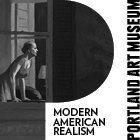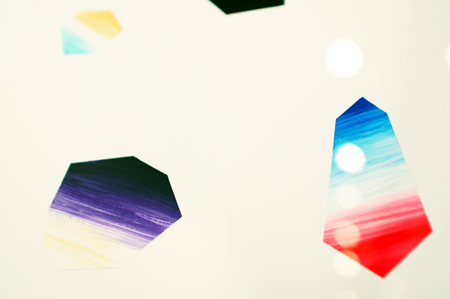
"Gradient X" (Detail) 2009, Midori Hirose
To write on a show that has already come down may seem to some a moot point. Yet, there are things past that do not leave us. There are works and events that fester and bloom in the brain as experience that is at once nebulous and unknowable to our speech. These experiential blossoms then ripen into oral histories that spread throughout a culture, becoming culture. To not bring them to life in speech would be to discontinue parts of their bestowed gifts, and thus I continue . . .
Midori Hirose's "L Sub to the Polynomial" at the New Nationale this past month echoes through the halls of my brain. The color gradients and relationships between figurative representation and abstraction are points Hirose visually makes with an eloquence that often eludes theorists and critics. As theorists endeavor to allude to ideas in thick language and erudite ideologies, Hirose simply sets laughing penciled portraits next to small angular families of color gradients. In so doing, the effective symbolism (and relevance) of abstraction as a real being moving through real space in real time is poetically reified.
The title of Hirose's exhibit, "L Sub to the Polynomial", is a mathematical formula Hirose described in her lecture at Nationale as a description of something which could not be made less, an essence pared down. There is a metaphysical nature to the use of colors and shapes as language which is mysteriously understood; understood here is intended as accepted, not as translatable. This understanding allows the viewer to see these pieces as they are: symbolic yet not exactly metaphorical. Hirose's work joins a current of contemporary artists and thinkers whose work explores ways of seeing. Richard Tuttle and Sol Lewitt come to mind as forefathers to this language, however Hirose's language is at once very much her own.
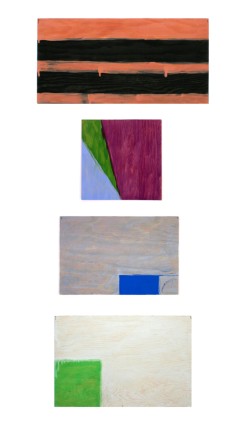
"Overlap (Two Perspectives)" 2007, Richard Tuttle, image courtesy of Sperone Westwater
In L sub to the Polynomial, Hirose investigates catalysts to not only ways of seeing but into the ways of listening. She induces our listening to the memory of an audible idea, in this case the audible idea of laughter. As the viewer moves through the show, the memory of laughter echoes through the mind and interacts with the other pieces. They become relatives in their placement next to one another, and the visual experience becomes multi-dimensional. Hirose's families of color gradients and graph flattened blobs float in the white space of the gallery, nodding to one another, vibrating with laughter memory: an abstract motherhood that hums without sound. What will be born between the conversations of these small families, their concert of idea and suggestion, their existential frankness?
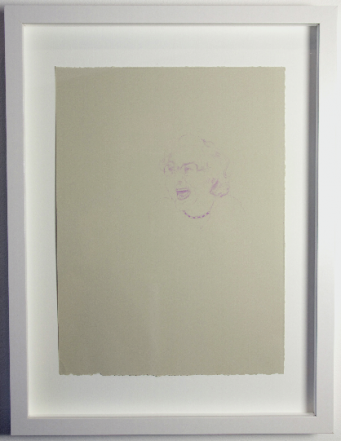
"Laugh V" 2010, Midori Hirose, image courtesy of Nationale
Graphite pencil portraits of laughter relate and interact with these shapes on a conversational level, almost as if both groups elicit some sort of conversing sound originating from their existential essences. Hirose is the humorous mystic, placing her laughter memory drawings across from the drawing titled "Berger Black", made in homage, she claims, to her love of hamburgers. She is modest in the display of her intelligence, as one questions her choice of the spelling. Is she referencing art history? making another joke? The show is wrought with a sense of play that belies the joy this maker and thinker takes in her work.
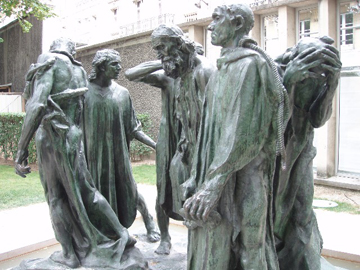
"The Berghers of Calais" 1889, Auguste Rodin
Seeing the scope of Hirose's work one can see a charge and command of her process and direction. There is a visible attention to painting, an honored respect to its tradition, and the vital renunciation that each painter must make in order to continue on with his or her own work. "L Sub to the Polynomial" is the mathematical formula towards a very painterly goal: to pare down a subject to its very rawest essence. There is a tangible curiosity that feeds itself in the act of her working and is thus inexhaustible. Hirose explores her materials with a sense of play, yet masters her materials skillfully and thoughtfully. This exploration seems to feed itself exponentially.
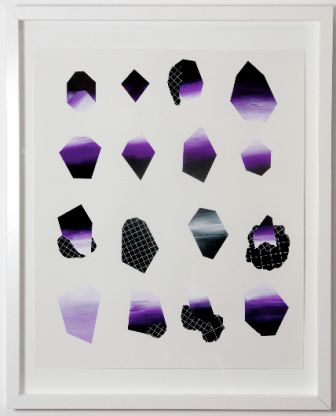
"16 Stoners III" 2009, Midori Hirose, image courtesy of Nationale
It is a mystery as to how these shapes hold and hum with their very certain integrities, certain philosophies. Is this a learned notion, a learned symbology, a learned language that is present somewhere within our visual culture, our unspoken value set? Is it an occurrence which is so prevalent that we may indeed rely on it as a constant? And if so, from where does this meter originate? The institutions? The academy? Our own eyes? Our implanted notions of kitsch and irony? Good and Bad? Dark and Light? The question remains mysterious, yet this language is indeed very real. For Hirose, L Sub to the Polynomial is her illustration of the language of this very integral, almost audible language of shapes. Through it rises the investigation into the state, irony, and relevance of the very real language of abstraction.
See more of Hirose's intriguing works in May at Gallery Homeland's space in Berlin, Germany.



